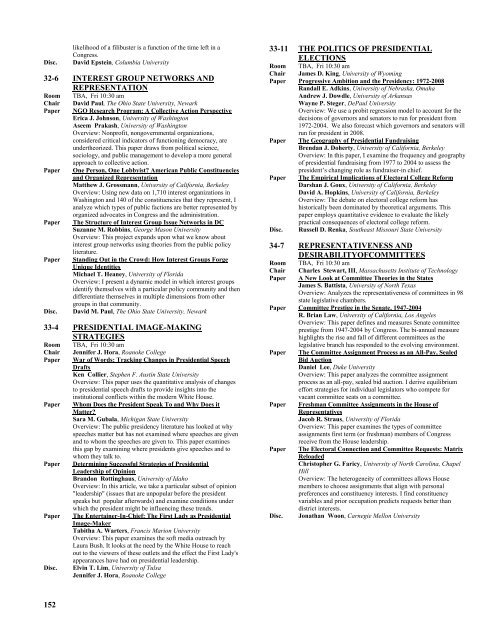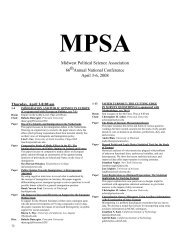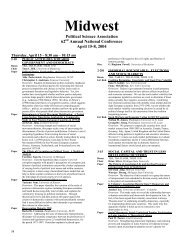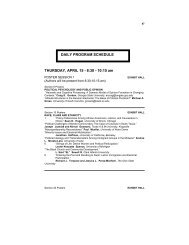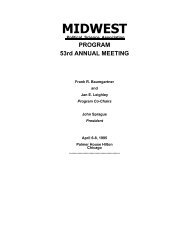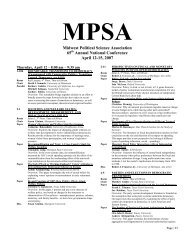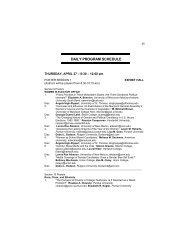Disc.likelihood of a filibuster is a function of the time left in aCongress.David Epstein, Columbia University32-6 INTEREST GROUP NETWORKS ANDREPRESENTATIONRoomChairPaperPaperPaperPaperDisc.TBA, Fri 10:30 amDavid Paul, The Ohio State University, NewarkNGO Research <strong>Program</strong>: A Collective Action PerspectiveErica J. Johnson, University of WashingtonAseem Prakash, University of WashingtonOverview: Nonprofit, nongovernmental organizations,considered critical indicators of functioning democracy, areundertheorized. This paper draws from political science,sociology, and public management to develop a more generalapproach to collective action.One Person, One Lobbyist? American Public Constituenciesand Organized RepresentationMatthew J. Grossmann, University of California, BerkeleyOverview: Using new data on 1,710 interest organizations inWashington and 140 of the constituencies that they represent, Ianalyze which types of public factions are better represented byorganized advocates in Congress and the administration.The Structure of Interest Group Issue Networks in DCSuzanne M. Robbins, George Mason UniversityOverview: This project expands upon what we know aboutinterest group networks using theories from the public policyliterature.Standing Out in the Crowd: How Interest Groups ForgeUnique IdentitiesMichael T. Heaney, University of FloridaOverview: I present a dynamic model in which interest groupsidentify themselves with a particular policy community and thendifferentiate themselves in multiple dimensions from othergroups in that community.David M. Paul, The Ohio State University, Newark33-4 PRESIDENTIAL IMAGE-MAKINGSTRATEGIESRoomChairPaperPaperPaperPaperDisc.TBA, Fri 10:30 amJennifer J. Hora, Roanoke CollegeWar of Words: Tracking Changes in Presidential SpeechDraftsKen Collier, Stephen F. Austin State UniversityOverview: This paper uses the quantitative analysis of changesto presidential speech drafts to provide insights into theinstitutional conflicts within the modern White House.Whom Does the President Speak To and Why Does itMatter?Sara M. Gubala, Michigan State UniversityOverview: The public presidency literature has looked at whyspeeches matter but has not examined where speeches are givenand to whom the speeches are given to. This paper examinesthis gap by examining where presidents give speeches and towhom they talk to.Determining Successful Strategies of PresidentialLeadership of OpinionBrandon Rottinghaus, University of IdahoOverview: In this article, we take a particular subset of opinion"leadership" (issues that are unpopular before the presidentspeaks but popular afterwards) and examine conditions underwhich the president might be influencing these trends.The Entertainer-In-Chief: The First Lady as PresidentialImage-MakerTabitha A. Warters, Francis Marion UniversityOverview: This paper examines the soft media outreach byLaura Bush. It looks at the need by the White House to reachout to the viewers of these outlets and the effect the First Lady'sappearances have had on presidential leadership.Elvin T. Lim, University of TulsaJennifer J. Hora, Roanoke College33-11 THE POLITICS OF PRESIDENTIALELECTIONSRoom TBA, Fri 10:30 amChair James D. King, University of WyomingPaper Progressive Ambition and the Presidency: 1972-2008Randall E. Adkins, University of Nebraska, OmahaAndrew J. Dowdle, University of ArkansasWayne P. Steger, DePaul UniversityOverview: We use a probit regression model to account for thedecisions of governors and senators to run for president from1972-2004. We also forecast which governors and senators willrun for president in 2008.PaperPaperDisc.The Geography of Presidential FundraisingBrendan J. Doherty, University of California, BerkeleyOverview: In this paper, I examine the frequency and geographyof presidential fundraising from 1977 to 2004 to assess thepresident’s changing role as fundraiser-in chief.The Empirical Implications of Electoral College ReformDarshan J. Goux, University of California, BerkeleyDavid A. Hopkins, University of California, BerkeleyOverview: The debate on electoral college reform hashistorically been dominated by theoretical arguments. Thispaper employs quantitative evidence to evaluate the likelypractical consequences of electoral college reform.Russell D. Renka, Southeast Missouri State University34-7 REPRESENTATIVENESS ANDDESIRABILITYOFCOMMITTEESRoomChairPaperTBA, Fri 10:30 amCharles Stewart, III, Massachusetts Institute of TechnologyA New Look at Committee Theories in the StatesJames S. Battista, University of North TexasOverview: Analyzes the representativeness of committees in 98state legislative chambers.Paper Committee Prestige in the Senate, 1947-2004R. Brian Law, University of California, Los AngelesOverview: This paper defines and measures Senate committeeprestige from 1947-2004 by Congress. The bi-annual measurehighlights the rise and fall of different committees as thelegislative branch has responded to the evolving environment.PaperPaperPaperDisc.The Committee Assignment Process as an All-Pay, SealedBid AuctionDaniel Lee, Duke UniversityOverview: This paper analyzes the committee assignmentprocess as an all-pay, sealed bid auction. I derive equilibriumeffort strategies for individual legislators who compete forvacant committee seats on a committee.Freshman Committee Assignments in the House ofRepresentativesJacob R. Straus, University of FloridaOverview: This paper examines the types of committeeassignments first term (or freshman) members of Congressreceive from the House leadership.The Electoral Connection and Committee Requests: MatrixReloadedChristopher G. Faricy, University of North Carolina, ChapelHillOverview: The heterogeneity of committees allows Housemembers to choose assignments that align with personalpreferences and constituency interests. I find constituencyvariables and prior occupation predicts requests better thandistrict interests.Jonathan Woon, Carnegie Mellon University152
34-14 WHY REPRESENTATIVES NEED AWHIPPINGRoomChairPaperPaperPaperPaperPaperDisc.TBA, Fri 10:30 amMatthew M. Schousen, Franklin & Marshall CollegeParty Voting and the Institutionalization of the WhipSystemBrad T. Gomez, University of South CarolinaOverview: This paper examines the institutionalization of theparty whip system in the Congress and its effect on intrapartycohesion and party voting. Using data from 1870-2004, I testthe whips' ability to signal party preferences and inducecompliance.Partisan vs. Institutional Leadership in the U.S. CongressMatthew N. Green, Catholic University of AmericaOverview: Congressional party leaders have acted at times onbehalf of institutional goals, such as protecting the power ofCongress, over partisan goals. In this project, I examine whenand why party leaders exercise such leadership.Party Power and the Expansion of the House WhipNetworksScott R. Meinke, Bucknell UniversityOverview: Proposes and tests changing explanations forexpanding whip systems in the House from the 1960s to thepresent, exploring the composition of the whip network andexamining the effects of whip membership on memberbehavior.Party Leadership and Floor Amendments in the U.S. SenateTimothy Werner, University of Wisconsin, MadisonOverview: Increases in Minority Leader tenure lead to thegreater strategic use of floor amendments as policymaking toolson significant legislation in the U.S. Senate. Increases inMajority Leader tenure have no effect on the suppression ofamendments.From Rules to Norms: The Role of Speaker's Precedents inthe HouseThomas J. Raven, Syracuse UniversityOverview: This paper examines the mechanism through whichrules are refined through precedents set by Speaker's rulings.Establishing a better understanding of this process will helpforge a critical link between changing rules and developingnorms.John W. Patty, Harvard University35-5 POLITICAL PARTIES AND ELECTIONSRoomChairPaperPaperDisc.TBA, Fri 10:30 amPaolino Philip, University of North TexasThe Electoral Consequences of Party Loyalty in CongressJamie L. Carson, University of GeorgiaGregory Koger, University of MontanaMatthew Lebo, Stony Brook UniversityOverview: We estimate the effects of each House member’sparty unity—the tendency of a member to vote with his or herparty on issues that divide the two major parties—on votemargin and probability of reelection from 1979 to 2004.Party Reputations and Candidate StrategiesJeffrey D. Grynaviski, University of ChicagoOverview: This paper introduces a simple formal model thatexplains how political parties' historical reputations shapecandidates' electoral strategies.Doug Roscoe, University of Massachusetts, Dartmouth36-1 DECISION MAKING ON U.S. COURTS OFAPPEALSRoomChairPaperTBA, Fri 10:30 amSteven Puro, St. Louis UniversityAn Examination of Recent Trends of Decision Making in theUS Courts of AppealsMark S. Hurwitz, Western Michigan UniversityAshlyn K. Kuersten, Western Michigan UniversityOverview: In this paper we examine a number of issue areasconcerning decision-making in the US Courts of Appeals forrecent years and compare these data with those from prior years,PaperPaperPaperDisc.based on release of the extension of the Songer Databasethrough 2003.Explaining Publication Areas of Federal Trial andAppellate Court JudgesSusan W. Johnson, University of North Carolina, GreensboroRonald Stidham, Appalachian State UniversityKenneth Manning, University of Massachusetts, DartmouthRobert A. Carp, University of HoustonOverview: This study seeks to address the question of whatcauses lower court judges to publish decisions in particularareas of case law.Small Group Theory and the U.S. Courts of AppealsWendy Martinek, Binghamton UniversityOverview: The collegial nature of decision-making on appellatecourts is typically considered only to the extent that collegialcontext offers opportunities for strategic behavior. Small grouptheory suggests a different (i.e., psychological) approach.Senior Judges' Decision-Making in the U.S. Courts ofAppealsRorie Spill Solberg, Oregon State UniversityLisa Holmes, University of VermontSusan Haire, University of GeorgiaOverview: The ability to take senior status provides federaljudges with an option beyond remaining fully active or retiringcompletely. This paper examines the effects of senior status ondecision making and policy in the U.S. Courts of Appeals.James C. Brent, San Jose State UniversitySean Farhang, University of California, Berkeley38-6 IMPLEMENTING THE "LAYER CAKE"RoomChairPaperPaperPaperPaperPaperDisc.TBA, Fri 10:30 amDuane D. Milne, West Chester UniversityStructure, Function, Politics, and Risk: Policy ReformUnder FederalismJoanna Mosser, Yale UniversityOverview: This paper argues for a risk-based approach to theproblem of institutional choice under federalism and exploreshow spatially rooted incentives and challenges shapeintergovernmental policy management.Organizations, Intergovernmental Relations, KnowledgeUse and KatrinaAdrian S. Petrescu, University of Texas, BrownsvilleOverview: Using organizational portfolio theory, I verify ifcongruence between structure of an organization and its type oftask it addesses may lower the likelihood of enacting andimplementing imperfect policies and processes. I test on theKatrina disaster.State Adjustments to Congressional Lawmaking: Adaptingto Stifling FederalismElizabeth A. O'Shaughnessy, University of Illinois, ChicagoOverview: Lately lawmaking in Congress is dominated by themajority party, and passage of federal preemptions continues. Inreaction, states must act to prevent their own policy innovationsfrom being stifled, indicating a new emergent pattern offederalism.Devolution in Practice: A Conceptual FrameworkAlison Gash, University of California, BerkeleyOverview: This paper presents a conceptual framework ofdevolution to address the following questions: What are theessential characteristics of devolution? Who are the key playersand what are their roles? How can we assess its benefits?Tandem-Institutions Transforming the Locus of FederalOversightEdward A. Miller, Brown UniversityOverview: This article argues that rather than isolating thejudiciary and placing it in a competitive relationship with otherinstitutions, federal oversight typically involves active support,or at least acquiescence, from multiple branches of government.Laura E. Evans, University of Washington153
- Page 1 and 2:
MidwestPolitical Science Associatio
- Page 4 and 5:
9-4 STATE BUILDING AND BUREAUCRATIC
- Page 6 and 7:
14-1 GLOBALIZATION AND SECURITYRoom
- Page 8 and 9:
PaperPaperDisc.The Divide: African
- Page 10 and 11:
29-210 INFORMAL ROUNDTABLE: CULTURE
- Page 12 and 13:
PaperDisc.Defining Federalism: The
- Page 14 and 15:
PaperDisc.estimates connections amo
- Page 16 and 17:
3-26 THE DETERMINANTS OF ECONOMICGR
- Page 18 and 19:
PaperPaperPaperDisc.Bad Civil Socie
- Page 20 and 21:
PaperPaperDisc.Voting Patterns in t
- Page 22 and 23:
PaperDisc.'Going Local': Candidate
- Page 24 and 25:
PaperPaperDisc.90Reflections on Lit
- Page 26 and 27:
Presenter Out of Time: Examining th
- Page 28 and 29:
is: to what extent are intergovernm
- Page 30 and 31:
Presenter Economic Inequality, Its
- Page 32 and 33:
PaperPaperPaperPaperDisc.during the
- Page 34 and 35:
10-3 BACK TO EUROPE? THE EU AND"EUR
- Page 36 and 37: PaperPaperPaperDisc.Interested Part
- Page 38 and 39: PaperPaperthatDisc.Don't Know, Don'
- Page 40 and 41: Disc.Suzanne Soule, Center for Civi
- Page 42 and 43: epistemology which is attentive to
- Page 44 and 45: 37-3 CONSTITUTIONAL INTERPRETATIONA
- Page 46 and 47: 47-201 INFORMAL ROUNDTABLE: RELIGIO
- Page 48 and 49: PaperPaperDisc.terms and reciprocal
- Page 50 and 51: PaperPaperPaperDisc.116Education, E
- Page 52 and 53: 19-202 INFORMAL ROUNDTABLE: YOUNG A
- Page 54 and 55: 26-6 ASIAN AMERICAN POLITICSRoomCha
- Page 56 and 57: PaperPaperPaperDisc.of how partisan
- Page 58 and 59: PaperPaperDisc.124An Experimental S
- Page 60 and 61: PaperPaperDisc.Policy Windows, Atte
- Page 62 and 63: Friday, April 21 - 8:30 am - 10:15
- Page 64 and 65: PaperPaperPaperDisc.The Determinant
- Page 66 and 67: PaperPaperDisc.A Simple Game-Theore
- Page 68 and 69: PaperDisc.partisans is causing chan
- Page 70 and 71: 28-201 INFORMAL ROUNDTABLE: DEWEY'S
- Page 72 and 73: 35-4 THE EFFECTS OF REDISTRICTING O
- Page 74 and 75: Presenter Regulation, Enforcement a
- Page 76 and 77: Friday, April 21 - 10: 30 am - 12:1
- Page 78 and 79: PaperPaperDisc.144Regional Minority
- Page 80 and 81: PaperPaperDisc.Administration of Gl
- Page 82 and 83: PaperPaperPaperDisc.The Paradox Soc
- Page 84 and 85: Disc.("Policy Mood") since 1972 usi
- Page 88 and 89: 38-301 POSTER SESSION: COMPARATIVEI
- Page 90 and 91: 54-1 SOCIAL ACTIVISM AND CIVICENGAG
- Page 92 and 93: 3-203 INFORMAL ROUNDTABLE: THE LEGA
- Page 94 and 95: PaperPaperPaperPaperDisc.Toward Res
- Page 96 and 97: Presenter The Shanghai Cooperation
- Page 98 and 99: PaperPaperPaperDisc.poised to becom
- Page 100 and 101: PaperDisc.chapter in Foucault's int
- Page 102 and 103: PaperDisc.Campaign Ad Images as Sig
- Page 104 and 105: 43-6 INDEPENDENT SCRUTINY OF AGENCI
- Page 106 and 107: Friday, April 21 - 3:45 pm - 5:30 p
- Page 108 and 109: 6-2 PARTIES AND PARTY DISCIPLINERoo
- Page 110 and 111: PaperDisc.assesses the impact of co
- Page 112 and 113: 19-301 POSTER SESSION: VOTING BEHAV
- Page 114 and 115: 24-9 WHO LEADS: UNTANGLING THERELAT
- Page 116 and 117: PaperPaperPaperDisc.182Understandin
- Page 118 and 119: Paper The Rehnquist Court and the N
- Page 120 and 121: PaperDisc.Revenge of Socialist Supe
- Page 122 and 123: Saturday, April 22 - 8:30 am - 10:1
- Page 124 and 125: PaperDisc.South Korean Public Opini
- Page 126 and 127: PaperDisc.several other variables b
- Page 128 and 129: 22-15 PRESIDENTIAL APPROVAL (Co-spo
- Page 130 and 131: PaperDisc.never seems to provide us
- Page 132 and 133: PaperPaperPaperDisc.Polarization an
- Page 134 and 135: PaperDisc.Networks of Local Governm
- Page 136 and 137:
47-203 INFORMAL ROUNDTABLE: RELIGIO
- Page 138 and 139:
PaperPaperPaperPaperDisc.Between De
- Page 140 and 141:
11-9 NEW THEORIES AND THUS NEWDEBAT
- Page 142 and 143:
PaperPaperPaperAre Political Market
- Page 144 and 145:
26-9 MINORITY REPRESENTATIONRoomCha
- Page 146 and 147:
PaperDisc.Evolving Political Machin
- Page 148 and 149:
PaperPaperPaperDisc.economic gains
- Page 150 and 151:
PaperPaperPaperDisc.A Social Versus
- Page 152 and 153:
Saturday, April 21 - 1:45 pm - 3:30
- Page 154 and 155:
PaperPaperDisc.Riptides in Ontario:
- Page 156 and 157:
PaperPaperPaperDisc."works," a stat
- Page 158 and 159:
PaperPaperPaperPaperDisc.Preference
- Page 160 and 161:
PaperPaperPaperDisc.226that encoura
- Page 162 and 163:
32-12 POLITICAL PARTIES IN ELECTION
- Page 164 and 165:
PaperPaperDisc.Challenging Others o
- Page 166 and 167:
52-3 SOCIAL POLICIES: CHALLENGES AN
- Page 168 and 169:
Saturday, April 22 - 3:45 pm - 5:30
- Page 170 and 171:
PaperDisc.It's Not the Economy Stup
- Page 172 and 173:
15-10 DEMOCRACY, EQUALITY, AND PEAC
- Page 174 and 175:
Presenter Polarization, Public Opin
- Page 176 and 177:
PaperDisc.John S. Mill and Alexis d
- Page 178 and 179:
PaperDisc.Lobbying by Transportatio
- Page 180 and 181:
42-202 INFORMAL ROUNDTABLE: DOMESTI
- Page 182 and 183:
Presenter Female Athletes Making He
- Page 184 and 185:
PaperPaperDisc.Micro-Level Determin
- Page 186 and 187:
PaperDisc.Governmental Structure, P
- Page 188 and 189:
PaperDisc.Social Class Identity and
- Page 190 and 191:
33-9 PRESIDENTIAL-CONGRESSIONALRELA
- Page 192 and 193:
PaperPaperDisc.Equal Employment Opp
- Page 194 and 195:
Sunday, April 23 - 10:30 am - 12:15
- Page 196 and 197:
PaperPaperPaperDisc.State Legitimac
- Page 198 and 199:
18-14 THE STUDY AND MEASUREMENT OFR
- Page 200 and 201:
28-14 ROUSSEAU RECONSIDEREDRoomChai
- Page 202 and 203:
PaperDisc.The Judicial Treatment of


